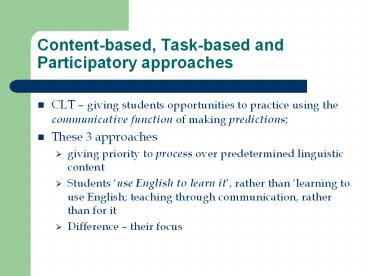Content-based, Task-based and Participatory approaches - PowerPoint PPT Presentation
1 / 11
Title:
Content-based, Task-based and Participatory approaches
Description:
Content-based, Task-based and Participatory approaches CLT giving students opportunities to practice using the communicative function of making predictions; – PowerPoint PPT presentation
Number of Views:1349
Avg rating:3.0/5.0
Title: Content-based, Task-based and Participatory approaches
1
Content-based, Task-based and Participatory
approaches
- CLT giving students opportunities to practice
using the communicative function of making
predictions - These 3 approaches
- giving priority to process over predetermined
linguistic content - Students use English to learn it, rather than
learning to use English teaching through
communication, rather than for it - Difference their focus
2
Content-based, Task-based and Participatory
approaches
- Content-based instruction
- For years, specialised language courses have
included content relevant to a particular
profession or academic discipline, e.g., for
airline pilots - It integrates the learning of language with the
learning of some other content, often academic
subject matter academic subjects provide
natural content for language instruction
3
Content-based, Task-based and Participatory
approaches
- In a second language environment, it offers the
significant advantage that second language
students do not have to postpone their academic
study until their language reaches a high level - Competency-based instruction an effective form
of content-based instruction for adult immigrants
offers an opportunity to develop their language
skills and vital life-coping skills
4
Content-based, Task-based and Participatory
approaches
- The subject matter content is used for language
teaching purposes - Language is learnt most effectively when it is
used as a medium to convey informational content
of interest to the students - When learners perceive the relevance of their
language use, they are motivated to learn - Vocabulary is easier to acquire when there are
contextual clues to help convey meaning - Communicative competence involves more than using
language conversationally but also the ability to
read, discuss and write about content from other
fields
5
Content-based, Task-based and Participatory
approaches
- Learners work with meaningful, cognitively
demanding language and content within the context
of authentic material and tasks - When they work with authentic subject matter,
students need language support - The teacher scaffolds the linguistic content,
i.e., helps learners say what they want to say by
building together with the students a complete
utterance - Teaching should build on students previous
experience
6
Content-based, Task-based and Participatory
approaches
- Task-based instruction
- A task-based approach aims to provide learners
with a natural context for language use - As learners work to complete a task, they have
abundant opportunity to interact - Learning can be facilitated by the interaction in
which learners work to correctly understand
others and make themselves understood - Learners will have opportunity to acquire
language that beyond their current level and use
them later
7
Content-based, Task-based and Participatory
approaches
- Prabhu (1987) identified 3 types of tasks an
information-gap activity, an opinion-gap
activity, and a reasoning-gap activity (p. 148) - An information-gap activity involves the exchange
of information among participants in order to
complete a task - An opinion-gap activity requires that students
give their personal preferences, feelings, or
attitudes in order to complete a task - A reasoning-gap activity requires students to
derive some new information by inferring it from
information they have been given
8
Content-based, Task-based and Participatory
approaches
- Prabhu feels that reasoning-gap tasks work best
- Information-gap tasks often require a single step
transfer of information, rather than sustained
negotiation - Opinion-gap tasks tend to be rather open-ended
- Reasoning-gap tasks encourage a more sustained
engagement with meaning, though they are still
characterized by a somewhat predictable use of
language
9
Content-based, Task-based and Participatory
approaches
- Participatory approach
- In some ways the participatory approach is
similar to the content approach - - It begins with content that is meaningful to the
students - Any forms that are worked upon emerge from that
content - Difference the nature of the content
- It is not the content of subject matter texts,
but rather content that is based on issues of
concern to students
10
Content-based, Task-based and Participatory
approaches
- What happens in the classroom should be connected
with what happens outside that has relevance to
the students - Education is most effective when it is
experience-centred, when it relates to students
real needs - A goal of the participatory approach is for
students to be evaluating their own learning to
increasingly direct it themselves - Students are motivated by their personal
involvement - Teachers are co-learners, asking questions of the
students, who are the experts on their own lives
11
Content-based, Task-based and Participatory
approaches
- The curriculum is not a predetermined product,
but the result of an ongoing context-specific
problem-posing process - Students can create their own materials, which,
in turn, can become texts for other students - Focus on linguistic form occurs within a focus on
content - Language skills are taught in service of action
for change, rather than in isolation - When knowledge is jointly constructed, it becomes
a tool to help students find voice and by finding
their voices, students can act in the world































